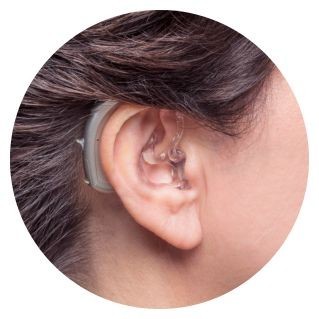Behind the Ear Hearing Aids
Exploring the BTE hearing aid style: Are they right for you?
| Hearing Aid UK 2025-11-04 Update |
What are Behind the Ear hearing aids?
Behind-the-Ear (BTE) hearing aids are a style of hearing aid in which the main portion of the device rests behind the ear and is linked to a component in the ear canal, either an earmould or a dome, through a slender tube.
They remain among the most popular types of hearing aids due to their powerful amplification capabilities and versatility for various degrees of hearing loss.
Behind the Ear hearing aids are far from the big brown banana of the past, and, yes, there are now small models available today. Due to this, BTE hearing aids have grown in popularity, but what are they, what are the benefits, and what are the disadvantages? Let's find out...
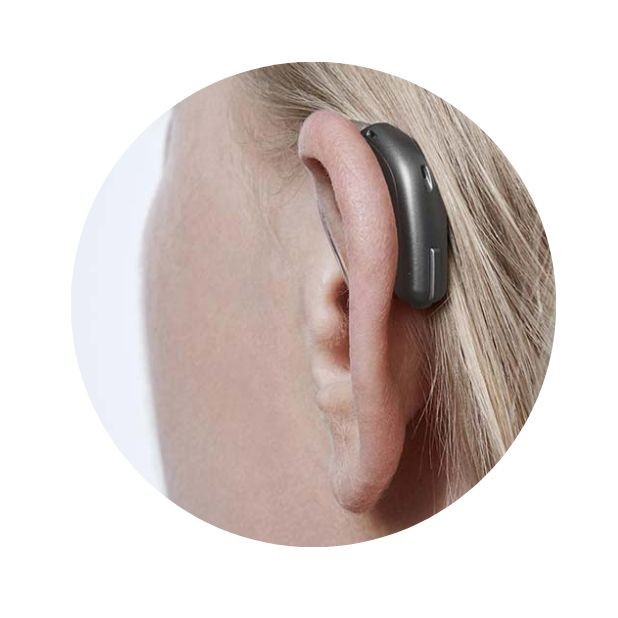
Common BTE Features
Seamless Bluetooth connectivity and compatibility
They can effortlessly connect to smart devices, enhancing accessibility and convenience. Behind the Ear hearing aids are suitable for addressing a wide range of hearing loss levels.
Adjustable for different ear sizes
They can comfortably fit ears of various sizes and ear canal dimensions.
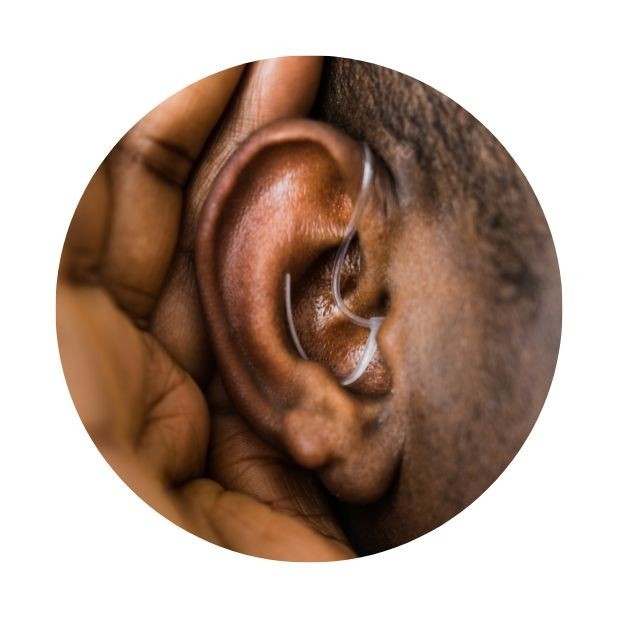
Capacity for Advanced Features
Their larger size allows for the incorporation of high-tech features, improving hearing aid performance.
User-friendly controls
Behind the Ear aids feature easily manageable controls for telecoil, volume adjustments, and program settings.
Enhanced battery power
With larger batteries, they provide extended usage on a single charge.
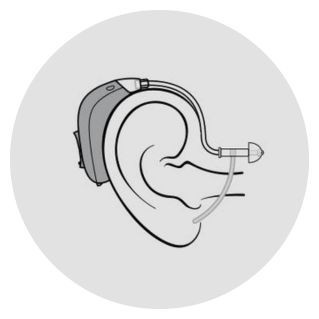
Behind the Ear Hearing Aid's Pros and Cons
What are the advantages of BTE hearing aids?
Behind the Ear hearing aid benefits
Are Behind the Ear hearing aids better? Behind the Ear (BTE) hearing aids are one of the more conspicuous types of hearing aids; however, many designs can actually be much smaller than you think, and their larger size allows for the incorporation of more technological features and often better battery life.
This hearing aid style also offers Bluetooth connectivity and can easily connect to smart devices wirelessly, which is also needed to support the technology needed to better support your hearing needs.
Powerful amplification and advanced technologies
Because Behind the Ear (BTE) hearing aids are slightly larger in size than some other hearing aid types, and also due to their separate Behind the Ear casing, they are able to provide higher levels of power and increased technological features than some smaller hearing aids.
They are able to contain larger battery types and support greater levels of amplification, and provide the power needed for the inclusion of some really advanced technology.
Super power options
The above means that Behind the Ear (BTE) hearing aids are suitable not only for those with more severe levels of hearing loss but also for those people who want their hearing aids to perform really well. View BTE hearing aids for severe hearing loss here
There’s a BTE for everyone
Behind the Ear (BTE) hearing aids are one of the most versatile hearing aid types due to their outside-of-the-ear design. This means that they can provide enough power to support even quite severe hearing loss and include enough technology to support the requirements of even the most active and dynamic of lifestyles.
Whatever your lifestyle or hearing loss type, there is likely to be a Behind the Ear (BTE) hearing aid to suit you.
Great battery life
Due to the Behind the Ear (BTE) hearing aid’s design having the casing that houses the battery sitting externally behind the ear, it means that if necessary, they can hold the larger size 3 batteries.
Rechargeable hearing aid choices
The above means that Behind the Ear (BTE) hearing aids can provide you with some of the best battery life of all of the hearing aid types available. BTE hearing aids are available in both disposable and rechargeable battery models.
Simple to use
Behind the Ear (BTE) hearing aids can be controlled either via a series of buttons or switches on the casing itself, or they can be replaced/combined with a variety of external controllers, such as smartphone apps or dedicated remote controls.
This variability of the design means that there is likely to be a Behind the Ear (BTE) hearing aid to suit almost everybody.
There are affordable options available
Due to their classic design and slightly larger size, Behind the Ear (BTE) hearing aids can often be some of the easiest to manufacture and so can be one of the most affordable varieties of hearing aids – obviously, this depends on the exact model that you choose.
However, if you choose to buy your hearing aid from us, then you will only pay one price regardless of the style of hearing aid that you choose.
Easier to clean and are comfortable
Behind the Ear (BTE) hearing aids are slightly larger and also sit largely outside of the ear, which means that they are much easier to clean (and also change the batteries) than some of the much smaller types of hearing aids. Most users find the BTE hearing aid style more comfortable, as they don’t sit far inside the ear canal.
Offer fewer feedback issues
The microphone and receiver are positioned far away from each other when compared to ITE hearing aids, which ultimately reduces the risk of feedback. There are also open-fit BTE hearing aids available, which means the thin tube sits in the ear canal, providing better air ventilation.
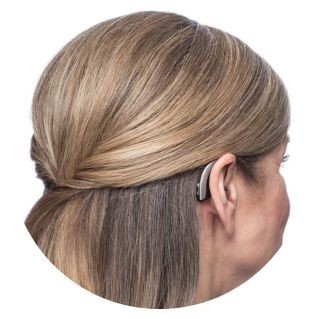
Cons of Behind the Ear (BTE) Hearing Aids
What are the disadvantages of Behind the Ear hearing aids?
Reduced sound quality
When you compare this style to that of the ITE or ITC hearing aids, the BTEs can sometimes not have the capacity to offer high levels of sound.
Wind noise
BTE hearing aid devices are more likely to have complications with wind noise when used in open spaces.
Less discreet
If discreet options are important to you, then the BTE style might not be right for you. They sit directly outside the ear; therefore, they are more liable to be noticed by other people. That being said, modern BTE hearing aids are much smaller than those of the past.

RIC vs BTE Hearing Aids
RIC and BTE hearing aids offer different benefits. RIC hearing aids feature a tiny device behind the ear, connected to the ear canal by a discreet wire and receiver.
They offer a more natural sound perception due to their placement closer to the eardrum. RICs are suitable for mild to moderate hearing loss and are less visible.
On the other hand, BTE hearing aids have a larger casing behind the ear, with a tube or earmold directing sound into the ear canal.
BTEs are versatile, accommodating various hearing loss levels, from mild to profound.
They are often easier to handle, making them suitable for users with dexterity issues.
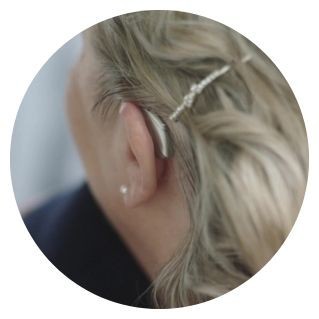
Behind the Ear Hearing Aid Care
How to clean Behind the Ear hearing aids: 5 easy tips
Cleaning BTE hearing aids is essential to maintain their functionality and hygiene. Remember to follow the specific cleaning and maintenance instructions provided by your hearing healthcare professional or the manufacturer to ensure the longevity and optimal performance of your BTE hearing aids.
Regular cleaning and care can extend the life of your hearing aids and keep your hearing experience at its best. Ask your audiologist for a BTE hearing aid cleaning kit so you can clean your devices at home at a time that suits you. Here are five tips to help you keep your BTE hearing aids clean:
1. Daily wipe down
Use a soft, dry cloth or tissue to gently wipe down the exterior of the hearing aids. This removes surface dirt, oils and moisture that can accumulate during the day. Ensure your hands are clean before handling them.
2. Brush the microphone and speaker ports
Use a soft-bristle brush or a hearing aid cleaning tool to carefully clean the microphone and speaker ports. These small openings can collect debris, which can affect sound quality. Be gentle to avoid damaging the delicate components.
3. Change wax filters
BTE hearing aids often have wax filters or guards in place to prevent earwax from entering the device. Check these filters regularly, and if you notice wax buildup, replace them following the manufacturer's instructions.
4. Inspect tubing and earmold
If your BTE hearing aids have tubing and earmolds, inspect them for signs of blockage or damage. Remove the tubing and clean it with warm, soapy water, then let it dry thoroughly before reattaching it.
5. Store properly
When not in use, store your BTE hearing aids in a protective case or container provided by your audiologist. This helps protect them from dust, moisture and physical damage.
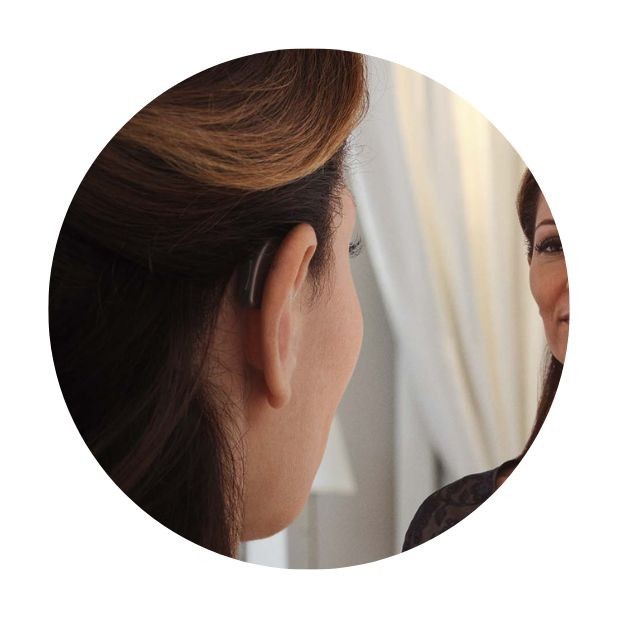
Summary
BTE hearing aids are a powerful and versatile solution for those with varying degrees of hearing loss.
With their robust amplification capabilities, durability, versatility in features and connectivity and comfortable design, they have become a popular choice among users and hearing care professionals alike.
By addressing the unique needs of people with mild to severe hearing loss, together with your audiologist, you can regain your ability to communicate effectively and participate fully in daily life.
Need more support with BTE hearing aids?
Ready to Experience the Power of BTE hearing aids? Book your free hearing test today and discover the comfort, clarity, and connectivity that Behind the Ear hearing aids can offer.
With local audiologists across the UK, free aftercare for life, and expert support every step of the way, there’s never been a better time to hear more of what matters. Join over 700 happy customers – rated excellent on Reviews.io!
Discover Other Hearing Aid Styles Below
Watch the Signia Behind the Ear hearing aid video below
Our specialist service includes:
Do not spend hundreds of pounds without getting a second opinion from us.
Please call us on 0800 567 7621
 Not only are the prices great, but the service is fantastic! Many thanks to your team.
Not only are the prices great, but the service is fantastic! Many thanks to your team.What's included in our hearing aid prices?
Other pages you might find useful
Common FAQs about Behind the Ear (BTE) hearing aids
Behind-the-ear hearing aids, similar to other hearing aid types, consist of three essential components: a microphone, an amplifier, and a speaker. These devices capture incoming sounds through the microphone, where they are subsequently transformed into electrical signals. The amplifier then boosts the strength of these signals, directing them into the ear via the hearing aid's speaker.
Click here to find out how other hearing aid styles, including how BTE hearing aids work.
What is the average cost of Behind the Ear hearing aids?
How much do BTE hearing aids cost? The price of BTE hearing aids is influenced by individual preferences and financial considerations, making it a variable factor unique to each person. Hence, it is important to consult with one of our hearing care professionals to identify the ideal hearing aid tailored to your needs.
It's worth noting that our hearing aid costs encompass more than just the device's price; they also encompass valuable benefits like lifetime aftercare at no additional charge. One of the main reasons why our customers buy BTE hearing aids from us is that we offer home visits and prices that are up to 40% off the high street.
Click here to compare and discover hearing aid prices in the UK.
What affordable Behind the Ear hearing aids are available?
There are plenty of BTE hearing aid options available for all different kinds of budgets. Click here to read more about affordable hearing aids in the UK.
What are the types of BTE hearing aids? What is the smallest BTE hearing aid?
The miniRITE is the most inconspicuous behind-the-ear hearing aid, positioned discreetly behind the ear and linked by a slim wire instead of a tube. These devices are incredibly compact, making them virtually imperceptible, and are available in a diverse array of colours to suit personal preferences.
The mini BTE hearing aids are compact and inconspicuous hearing devices that rest discreetly behind the ear. They are designed for enhanced comfort and aesthetics, offering a smaller and more streamlined profile compared to traditional BTE models. Despite its reduced size, the mini BTE retains powerful sound amplification capabilities and is available in various styles and colours to cater to individual preferences.
Can you wear Behind-the-Ear hearing aids with glasses?
Indeed, you can comfortably wear your BTE hearing aids and glasses together. To ensure a comfortable fit, simply put on your glasses first and then position your hearing aids around the temples of your glasses. If needed, consider reaching out to your optometrist to have your glasses and hearing aids adjusted for optimal comfort and wearability.
How to insert BTE hearing aids
Indeed, you can comfortably wear your behind-the-ear hearing aids alongside your glasses. To ensure a comfortable fit, simply put on your glasses first and then position your hearing aids around the temples of your glasses. If needed, consider reaching out to your optometrist to have your glasses and hearing aids adjusted for optimal comfort and wearability.
What is the difference between ITE and BTE hearing aids
Here's a comparison of the key differences between ITE and BTE hearing aids:
1. Placement:
ITE: They are typically more discreet and less visible.
BTE: They are more visible but offer advantages in terms of power and versatility.
2. Size and Visibility:
ITE: ITE hearing aids are smaller and fit discreetly inside the ear, making them less noticeable.
BTE: BTE hearing aids are larger and more visible because they sit behind the ear.
3. Hearing Loss Severity:
ITE: ITE hearing aids are suitable for a wide range of hearing loss levels, from mild to moderately severe.
BTE: BTE hearing aids can accommodate a broader spectrum of hearing loss, due to their larger size and more powerful amplification capabilities.
4. Customisation:
ITE: ITE hearing aids are custom-molded to fit the individual's ear, ensuring a snug and comfortable fit.
BTE: BTE hearing aids use standard earmolds or earpieces, which can be customised.
5. Features and Battery Life:
ITE: Smaller ITE hearing aids may have limited space for features and smaller batteries, which can result in shorter battery life.
BTE: BTE hearing aids can accommodate more advanced features, including directional microphones, Bluetooth connectivity, and larger batteries, which often provide longer battery life.
6. Feedback and Occlusion:
ITE: ITE hearing aids may be prone to feedback (whistling) and may cause a sense of occlusion (feeling "plugged up" in the ear) due to their placement in the ear canal.
BTE: BTE hearing aids are less likely to cause feedback and occlusion because the sound is directed from behind the ear.
8. Durability:
ITE: ITE hearing aids may be more susceptible to damage from moisture, wax, and ear canal shape changes.
BTE: BTE hearing aids are often more robust and durable, making them suitable for active lifestyles.
Are Behind the Ear hearing aids waterproof?
While most hearing aids, including Behind-the-Ear (BTE) models, aren’t fully waterproof, many now offer varying degrees of water resistance thanks to advanced nano-coating and sealing technologies. This means they can handle moisture, sweat, and rain, but long-term submersion is generally not advised unless the model is specifically designed for it.
For those needing hearing aids for activities like swimming, look for models specifically rated as "waterproof" or highly water-resistant, such as those with an IP68 rating.
Are Behind the Ear hearing aids uncomfortable?
Many users find Behind-the-Ear (BTE) hearing aids comfortable, as the main part rests behind the ear, with only a small dome or tube in the ear canal. This design reduces the feeling of a "blocked" ear.
BTE hearing aids are easy to handle, making them ideal for those with dexterity issues or arthritis. They’re also a good fit for people who wear glasses, as they sit comfortably behind the ear without interfering with the frames. These aids are also better for those with severe hearing loss, offering larger batteries and more power while remaining comfortable.
While more visible than In-the-Ear models, BTE hearing aids are a practical and comfortable choice for many users.
Behind the Ear hearing aid battery size
Behind-the-Ear (BTE) hearing aid styles historically use size 13 and 312 batteries. Whereas, In-the-ear (ITE) hearing aids usually use size 312 or 10 batteries. To make it easier, each size has an industry-standard colour code. You can learn more about hearing aid batteries here
Behind the Ear hearing aid brands
All hearing aid brands offer BTE hearing aids. Here are a few examples of our customers' popular choices below:
►Phonak Behind the Ear hearing aids
Ask the Experts
6 Morton Lane
Walkwood
Redditch
Worcestershire
B97 5QA
Latest Launch
When we refer to a product as 'Latest Launch', we mean it is the latest to be released on the market.
New
When we refer to a product as 'New', we mean that the product is the newest hearing aid model on the market.
When we refer to a product as 'Superseded', we mean that there is a newer range available which replaces and improves on this product.
Older Model
When we refer to a product as an 'Older Model', we mean that it is has been superseded by at least two more recent hearing aid ranges.

